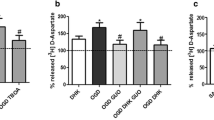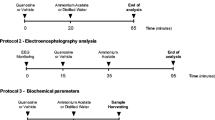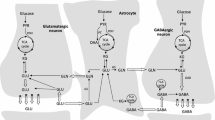Abstract
Ammonia neurotoxicity is associated with overactivation of N-methyl-d-aspartate (NMDA) receptors leading to enhanced nitric oxide and cyclic GMP synthesis and to accumulation of reactive oxygen and nitrogen species. Ammonia is detoxified in the brain via synthesis of glutamine, which if accumulated in excess contributes to astrocytic swelling, mitochondrial dysfunction and cerebral edema. This study was aimed at testing the hypothesis that the activity of the NMDA/NO/cGMP pathway is controlled by the ammonia-induced production of Gln in the brain. Ammonium chloride (final concentration 5 mM), infused for 40 min to the rat striatum via a microdialysis probe, caused a significant increase in Gln (by 40%), NO oxidation products (nitrite+nitrate = NOx) (by 35%) and cGMP (by 50%) concentration in the microdialysate. A Gln synthetase inhibitor, methionine sulfoximine (MSO, 5 mM), added directly to the microdialysate, completely prevented ammonia-mediated production of Gln, and paradoxically, it increased ammonia-mediated production of NOx and cGMP by 230% and 250%, respectively. Of note, MSO given alone significantly reduced basal Gln concentration in the rat striatum, had no effect on the basal NOx concentration, and attenuated basal concentration of cGMP in the microdialysate by 50%. The results of the present study suggest that Gln, at physiological concentrations, may ameliorate excessive activation of the NO–cGMP pathway by neurotoxic concentrations of ammonia. However, in view of potential direct interference of MSO with the pathway, exogenously added Gln and less toxic modulators of Gln content and/or transport will have to be employed in further studies on the underlying mechanisms.




Similar content being viewed by others
References
Fan P, Szerb JC (1993) Effects of ammonium ions on synaptic transmission and on responses to quisqualate and N-methyl-d-aspartate in hippocampal CA1 pyramidal neurons in vitro. Brain Res 632:225–231
Hermenegildo C, Monfort P, Felipo V (2000) Activation of NMDA receptors in rat brain in vivo following acute ammonia intoxication: characterization by in vivo brain microdialysis. Hepatology 31:709–715
Schliess F, Gorg B, Fischer R et al (2002) Ammonia induces MK-801-sensitive nitration and phosphorylation of protein tyrosine residues in rat astrocytes. FASEB J 16:739–741
Schliess F, Foster N, Gorg B et al (2004) Astrocyte swelling increases protein tyrosine nitration in cultured rat astrocytes. Glia 47:21–29
Murthy CR, Rama Rao KV, Bai G et al (2001) Ammonia-induced production of free radicals in primary cultures of rat astrocytes. J Neurosci Res 66:282–288
Hilgier W, Anderzhanova E, Oja SS et al (2003) Taurine reduces ammonia- and N-methyl-D-aspartate-induced accumulation of cyclic GMP and hydroxyl radicals in microdialysates of the rat striatum. Eur J Pharmacol 468:21–25
Kosenko E, Venediktova N, Kaminsky Y et al (2003) Sources of oxygen radicals in brain in acute ammonia intoxication in vivo. Brain Res 981:193–200
Haussinger D, Gorg B, Reinehr R et al (2005) Protein tyrosine nitration in hyperammonemia and hepatic encephalopathy. Metab Brain Dis 20:285–294
Swamy M, Zakaria AZ, Govindasamy C et al (2005) Effects of acute ammonia toxicity on nitric oxide (NO), citrulline-NO cycle enzymes, arginase and related metabolites in different regions of rat brain. Neurosci Res 53:116–122
Hilgier W, Oja SS, Saransaari P et al (2005) Taurine prevents ammonia-induced accumulation of cyclic GMP in rat striatum by interaction with GABAA and glycine receptors. Brain Res 1043:242–246
Albrecht J, Wegrzynowicz M (2007) Cyclic GMP in blood and minimal hepatic encephalopathy: fine-tuning of the diagnosis. J Mol Med 85:203–205
Hilgier W, Oja SS, Saransaari P et al (2004) A novel glycine site-specific N-methyl-D-aspartate receptor antagonist prevents activation of the NMDA/NO/CGMP pathway by ammonia. Brain Res 1015:186–188
Takahashi H, Koehler RC, Brusilow SW et al (1991) Inhibition of brain glutamine accumulation prevents cerebral edema in hyperammonemic rats. Am J Physiol 261:H825–H829
Willard-Mack CL, Koehler RC, Hirata T et al (1996) Inhibition of glutamine synthetase reduces ammonia induced astrocyte swelling in rat. Neuroscience 71:589–599
Tofteng F, Hauerberg J, Hansen BA et al (2006) Persistent arterial hyperammonemia increases the concentration of glutamine and alanine in the brain and correlates with intracranial pressure in patients with fulminant hepatic failure. J Cereb Blood Flow Metab 26:21–27
Albrecht J, Norenberg MD (2006) Glutamine: a Trojan horse in ammonia neurotoxicity. Hepatology 44:788–794
Ziemińska E, Dolińska M, Łazarewicz JW et al (2000) Induction of permeability transition and swelling of rat brain mitochondria by glutamine. Neurotoxicology 21:295–300
Rama Rao KV, Jayakumar AR, Norenberg MD (2003) Induction of the mitochondrial permeability transition in cultured astrocytes by glutamine. Neurochem Int 43:517–523
Jayakumar AR, Rama Rao KV, Schousboe A et al (2004) Glutamine-induced free radical production in cultured astrocytes. Glia 46:296–301
Suzuki K, Matsuo N, Moriguchi T et al (1992) Changes in brain ECF amino acids in rats with experimentally induced hyperammonemia. Metab Brain Dis 7:63–75
McArdle P, Penning DH, Dexter F et al (1996) Flumazenil does not affect the increase in rat hippocampal extracellular glutamate concentration produced during thioacetamide-induced hepatic encephalopathy. Metab Brain Dis 11:329–342
Rose C, Michalak A, Pannunzio M et al (2000) Mild hypothermia delays the onset of coma and prevents brain edema and extracellular brain glutamate accumulation in rats with acute liver failure. Hepatology 31:872–877
Paulsen RE, Odden E, Fonnum F (1988) Importance of glutamine for gamma-aminobutyric acid synthesis in rat neostriatum in vivo. J Neurochem 51:1294–1299
Fonnum F, Paulsen RE (1990) Comparison of transmitter amino acid levels in rat globus pallidus and neostriatum during hypoglycemia or after treatment with methionine sulfoximine or gamma-vinyl gamma-aminobutyric acid. J Neurochem 54:1253–1257
Paxinos G, Watson C (1982) The rat brain in stereotaxic coordinates. Academic Press, New York
Zielińska M, Hilgier W, Borkowska HD et al (2002) Ammonia-induced extracellular accumulation of taurine in the rat striatum in vivo: role of ionotropic glutamate receptors. Neurochem Res 27:37–42
Pye IF, Stonier C, McGale EHF (1978) Double-enzymatic assay for determination of glutamine and glutamic acid in cerebrospinal fluid and plasma. Anal Chem 50:951–953
Mączewski M, Beręsewicz A (2003) Role of nitric oxide and free radicals in cardioprotection by blocking Na+/H+ and Na+/Ca2+ exchange in rat heart. Eur J Pharmacol 461:139–147
Vogels BA, Maas MA, Daalhuisen J et al (1997) Memantine, a noncompetitive NMDA receptor antagonist improves hyperammonemia-induced encephalopathy and acute hepatic encephalopathy in rats. Hepatology 25:820–827
Master S, Gottstein J, Blei AT (1999) Cerebral blood flow and the development of ammonia-induced brain edema in rats after portacaval anastomosis. Hepatology 30:876–880
Kosenko E, Kaminski Y, Lopata O et al (1999) Blocking NMDA receptors prevents the oxidative stress induced by acute ammonia intoxication. Free Radic Biol Med 26:1369–1374
Dolińska M, Hilgier W, Albrecht J (1996) Ammonia stimulates glutamine uptake to the cerebral non-synaptic mitochondria of the rat. Neurosci Lett 213:45–48
de Knegt RJ, Schalm SW, van der Rijt CC et al (1994) Extracellular brain glutamate during acute liver failure and during acute hyperammonemia simulating acute liver failure: an experimental study based on in vivo brain dialysis. J Hepatol 20:19–26
Vogels BA, van Steynen B, Maas MA et al (1997) The effects of ammonia and portal-systemic shunting on brain metabolism, neurotransmission and intracranial hypertension in hyperammonaemia-induced encephalopathy. J Hepatol 26:387–395
Kanamori K, Ross BD (2005) Suppression of glial glutamine release to the extracellular fluid studied in vivo by NMR and microdialysis in hyperammonemic rat brain. J Neurochem 94:74–85
Hecker M, Mitchell JA, Swierkosz TA et al (1990) Inhibition by L-glutamine of the release of endothelium-derived relaxing factor from cultured endothelial cells. Br J Pharmacol 101:237–239
Arnal JF, Munzel T, Venema RC et al (1995) Interactions between L-arginine and L-glutamine change endothelial NO production. An effect independent of NO synthase substrate availability. J Clin Invest 95:2565–2572
Meininger CJ, Kelly KA, Li H et al (2000) Glucosamine inhibits inducible nitric oxide synthesis. Biochem Biophys Res Commun 279:234–239
Wu G, Haynes TE, Li H et al (2001) Glutamine metabolism to glucosamine is necessary for glutamine inhibition of endothelial nitric oxide synthesis. Biochem J 353:245–252
Shaw CA, Bains JS, Pasqualotto BA et al (1999) Methionine sulfoximine shows excitotoxic actions in rat cortical slices. Can J Physiol Pharmacol 77:871–877
Zielińska M, Stafiej A, Law RO et al (2004) Effects of methionine sulfoximine on the glutamine and glutamate content and cell volume in rat cerebral cortical slices: involvement of mechanisms not related to inhibition of glutamine synthesis. Neurotoxicology 25:443–449
Palekar AG, Tate SS, Meister A (1975) Decrease in glutathione levels of kidney and liver after injection of methionine sulfoximine into rats. Biochem Biophys Res Commun 62:651–657
Meister A, Griffith OW (1979) Effects of methionine sulfoximine analogs on the synthesis of glutamine and glutathione: possible chemotherapeutic implications. Cancer Treat Rep 63:1115–1121
Węgrzynowicz M, Hilgier W, Dybel A, et al (2007) Upregulation of cerebral cortical glutathione synthesis by ammonia in vivo and in cultured glial cells: the role of cystine uptake. Neurochem Int 50:883–889
Rodriguez-Diaz M, Alonso TJ, Perdomo-Diaz J et al (2005) Glial regulation of nonsynaptic extracellular glutamate in the substantia nigra. Glia 49:134–142
Bacci A, Sancini G, Verderio C et al (2002) Block of glutamate-glutamine cycle between astrocytes and neurons inhibits epileptiform activity in hippocampus. J Neurophysiol 88:2302–2310
Le Meur K, Galante M, Angulo MC, et al (2007) Tonic activation of NMDA receptors by ambient glutamate of non-synaptic origin in the rat hippocampus. J Physiol 580:373–383
Acknowledgments
The study was supported by Ministry of Science and Information, Grant 2P05A 066 28 (to J.A.), and by the competitive research funding of Pirkanmaa Hospital District (to S.S.O and P.S.).
Author information
Authors and Affiliations
Corresponding author
Additional information
Special issue article in honor of Dr. Frode Fonnum.
Wojciech Hilgier and Michal Węgrzynowicz contributed equally to this work.
Rights and permissions
About this article
Cite this article
Hilgier, W., Węgrzynowicz, M., Mączewski, M. et al. Effect of Glutamine Synthesis Inhibition with Methionine Sulfoximine on the Nitric Oxide–Cyclic GMP Pathway in the Rat Striatum Treated Acutely with Ammonia: A Microdialysis Study. Neurochem Res 33, 267–272 (2008). https://doi.org/10.1007/s11064-007-9455-1
Received:
Accepted:
Published:
Issue Date:
DOI: https://doi.org/10.1007/s11064-007-9455-1




